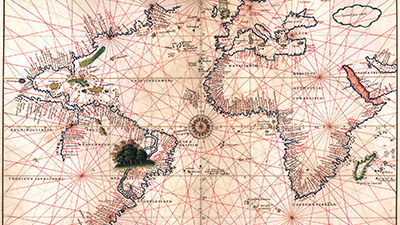Transoceanic Connections
Teacher Resources
Driving Question: How did economic developments and new transoceanic connections affect social structures in different parts of the world from c. 1450 to 1750 CE?
The first truly global age—full of both prosperity and tragedy—forever altered the course of human history. The already massive, complex trading systems within the Americas and Afro-Eurasia were linked by the Columbian Exchange, creating a network that carried goods, people, ideas, and germs across the world. New maritime empires exerted control over vast oceans and diverse populations, the impacts of which can still be seen today.
Learning Objectives:
- Explain how technological, economic, and philosophical factors contributed to changing patterns of trade and travel from 1450 to 1750.
- Evaluate the causes and effects of the Columbian Exchange in different regions of the world from 1450 to 1750.
- Use historical thinking skills and reasoning processes such as claim testing, sourcing, and continuity and change over time to evaluate historical events and processes.
Vocab Terms:
- demographic
- ecological
- enslave
- exchange
- indigenous
Opener: Transoceanic Connections
To teach this lesson step, refer to page 3 of the Lesson 4.0 Teaching Guide.
Curious how other teachers approach this topic. Read Origins of Transoceanic Connections Lessons Resources in the Community Forum.
What does it mean to in a “Global Age”? As you enter this unit on the First Global Age hypothesize what this really means.
Unit 4 Overview
To teach this lesson step, refer to page 3 of the Lesson 4.0 Teaching Guide.
If you’ve ever been to Louisiana, you may have tried Gumbo. It’s often associated with that state; however, the history of how that recipe came to be there can teach us a lot about diffusion during the Columbian Exchange!
-
Guiding Questions
-
Before you watch
Preview the questions below, and then review the transcript.
While you watch
Look for answers to these questions:
- What does John Arthur mean when he says that gumbo came “from many places … and from one place”?
- How were Europeans able to establish overseas empires all over the world from 1450 to 1750?
- What was the Columbian Exchange and what were some positive and negative aspects of this exchange?
- Why does John Arthur say that the Columbian Exchange was really more of an extraction than an exchange?
- How can you analyze the history of gumbo using the themes of governance, cultural developments and interactions, social interactions and organization, and humans and the environment?
After you watch
Respond to the following questions:
- Innovations in navigation and technology like gunpowder weapons helped Europeans conquer parts of the Americas and establish overseas empires. How did Europeans obtain these technologies?
- How did empires change and stay the same from Unit 3 to Unit 4?
Key Ideas
Unit 4 Introduction: Transoceanic Interconnections 1450 to 1750
To teach this lesson step, refer to page 4 of the Lesson 4.0 Teaching Guide.
Many items, ideas, and even diseases were traded during the Columbian Exchange—but not all trades were mutually beneficial swaps.
-
Guiding Questions
-
Before you read
Preview the questions below, and then skim the article. Be sure to look at the section headings and any images.
While you read
Look for answers to these questions:
- What motivated Europeans to explore new trade routes to Asia, and what technologies helped them?
- What was the Columbian Exchange? What was exchanged?
- What was the “Great Dying”?
- How did the Columbian Exchange change economies?
After you read
Look for answers to these questions:
- The last two units have covered the development of regional trade networks from c. 1200 to 1450 CE and the growth of land-based empires from c. 1450 to 1750 CE. How did these two trends help produce the Columbian Exchange and the development of large European overseas empires?
- The author explains the various ways that the Columbian Exchange reshaped politics, economics, and culture. Using the cultural developments and interactions theme, explain how the arrival of a new food might change a society. How does this answer change if you think about this through the theme of economic systems?
Closer: Transoceanic Connections
To teach this lesson step, refer to page 6 of the Lesson 4.0 Teaching Guide.
Closers are a great way to informally assess student progress. Learn more in our OER Project Assessment Guide.
It’s “Themes” time again! In this lesson, you’ll categorize statements according to the AP Themes!



